-
ICMag with help from Landrace Warden and The Vault is running a NEW contest in November! You can check it here. Prizes are seeds & forum premium access. Come join in!
You are using an out of date browser. It may not display this or other websites correctly.
You should upgrade or use an alternative browser.
You should upgrade or use an alternative browser.
Cannabis grafting
- Thread starter BobbyIronsights
- Start date
SuperWeed
Member
Thank SuperWeed! I wish I kept all the genetic I've work with in the past. I had some of the best genetic from the Super Sativa Seeds Club at the end of the 90th and I wish I had save them... What happened with your SuperMom in 2015?
Cops.

Darpa
Member
7 days is all you need to make a viable and healthy graft. Here an update on the grafting experiment. All 9 graft are doing fine and their auxiliary buds doubled in size within just a couple of days.
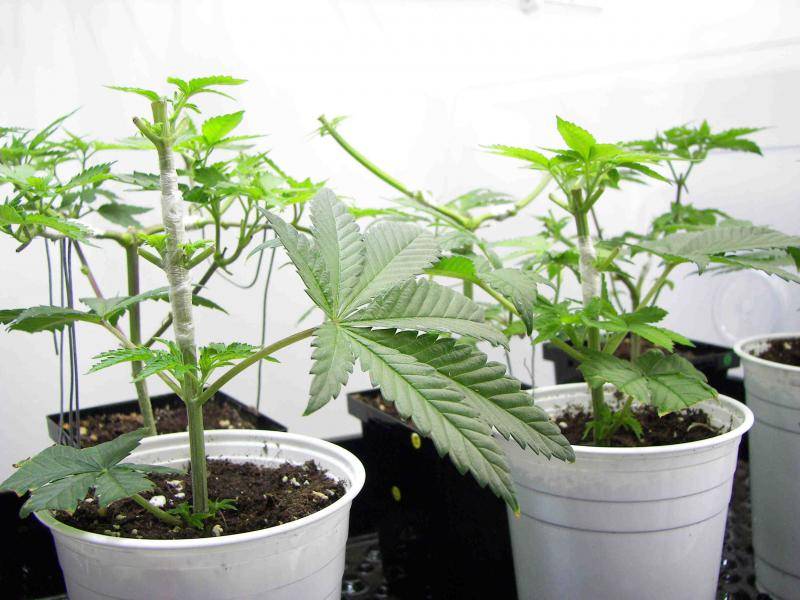
Here is an example of the fusion between the scion and the rootstock steam (7 day after the initial V-Graft)
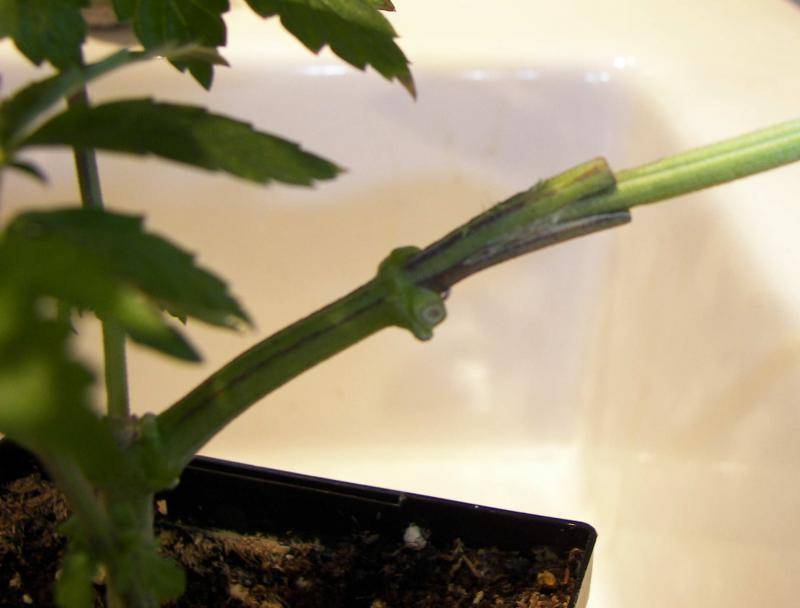
Closer look:
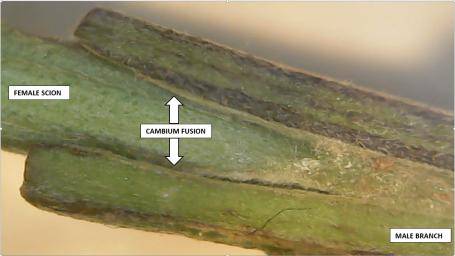
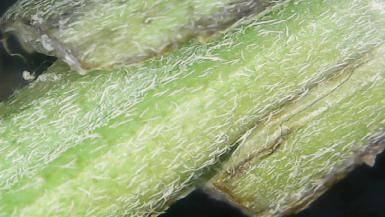
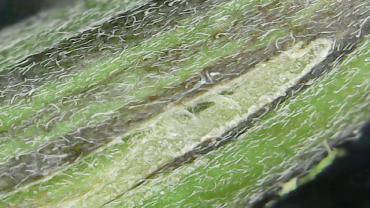
Here is an example of the fusion between the scion and the rootstock steam (7 day after the initial V-Graft)
Closer look:
Darpa
Member
Cool stuff, how are you wrapping these? is that just saran/plastic wrap?
There is grafting tape or grafting clip that can be use, but I personally use saran / plastic wrap that work just fine... just cheaper and you get the same result.
Darpa
Member
Ok, here we go again with an other experiment, since all of the V-Graft (wedge graft) and the auxiliary buds side grafting (chip grafting) worked with a 100 % success rate, here is a trial of a trunk and root system fusion.
Here is the two female specimen used in the experiment:
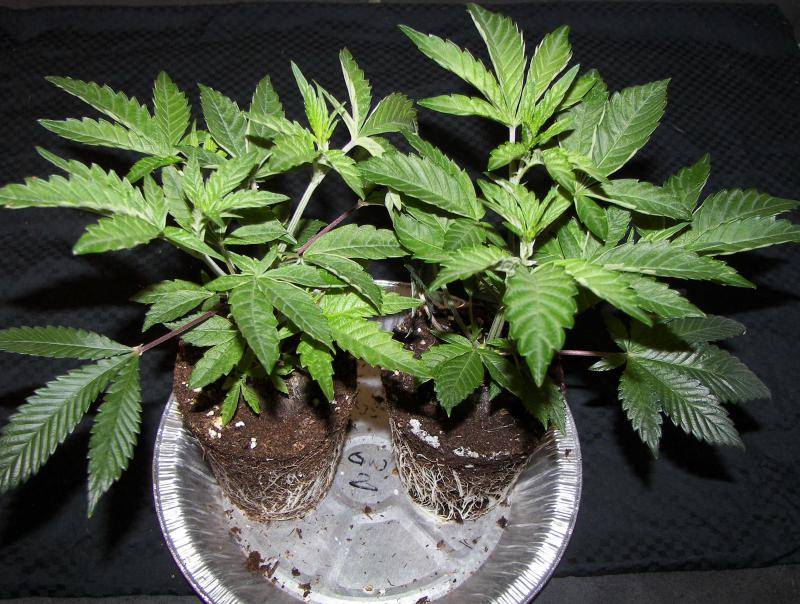
So I cut half of the root system on the two plant (in order to make full contact below and above ground):
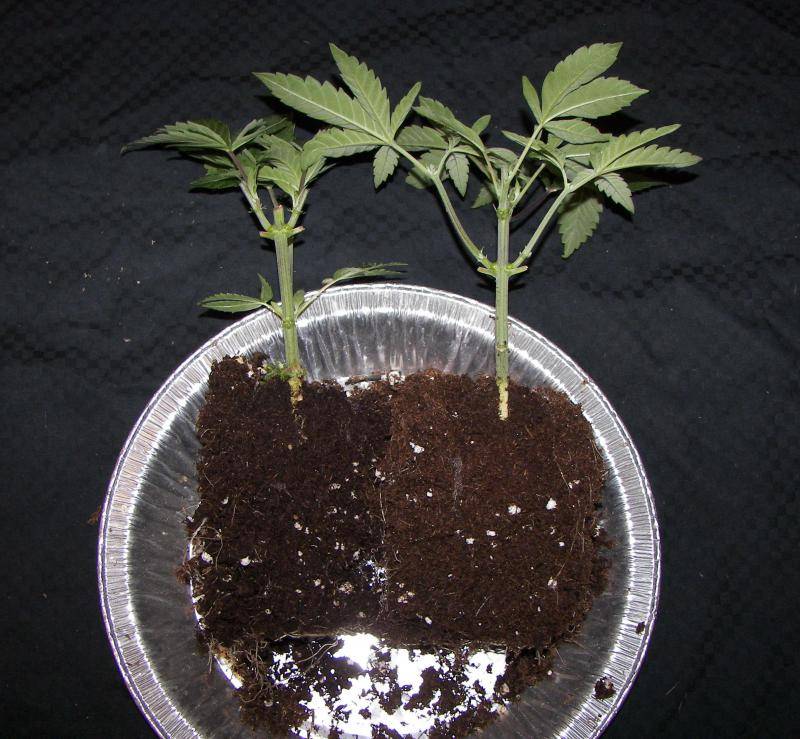
I made an vertical incision on each stem of about one inch in order to expose the cambium. I should have use a bigger container but the were inserted really closes one to the other in the same pot:
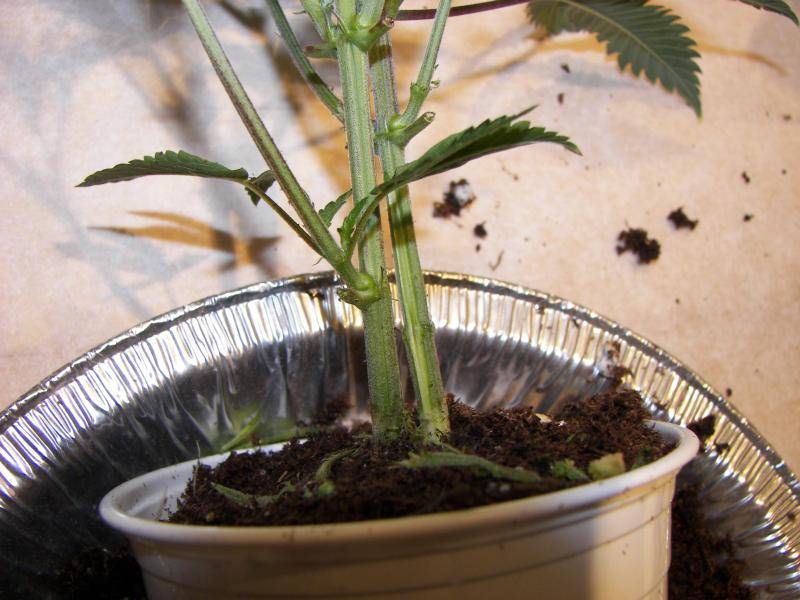
Then, as usual, they were firmly wrapped together:
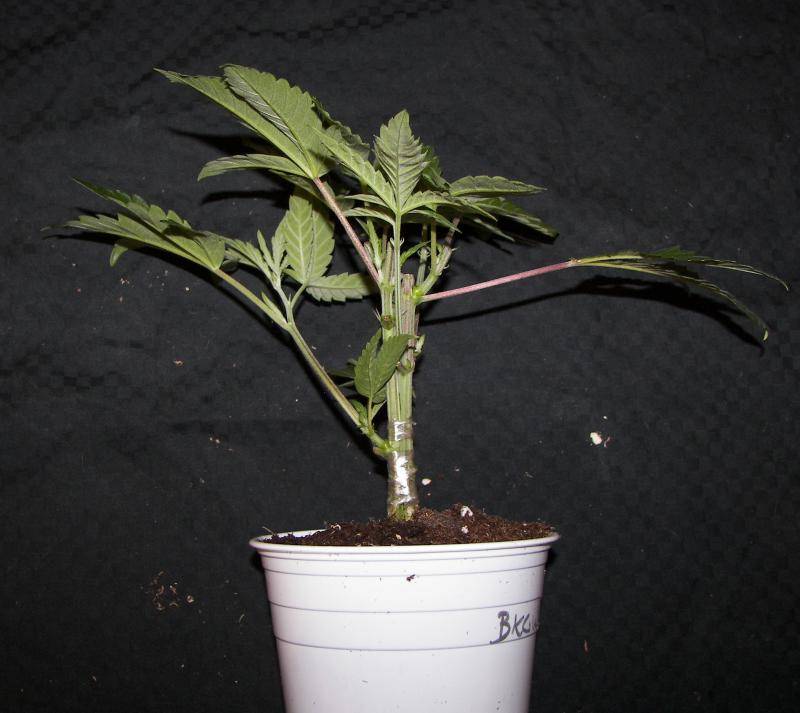
Here is the two female specimen used in the experiment:
So I cut half of the root system on the two plant (in order to make full contact below and above ground):
I made an vertical incision on each stem of about one inch in order to expose the cambium. I should have use a bigger container but the were inserted really closes one to the other in the same pot:
Then, as usual, they were firmly wrapped together:
SuperWeed
Member
Here is the final result:
[URL=https://www.icmag.com/ic/picture.php?albumid=70944&pictureid=1692043&thumb=1]View Image[/url]
It will rest under the dome for at least 5 day...
[URL=https://www.icmag.com/ic/picture.php?albumid=70944&pictureid=1692044&thumb=1]View Image[/url]
Next experiment: Grafting on a potato stem. Why? Why not!
[URL=https://www.icmag.com/ic/picture.php?albumid=70944&pictureid=1692045&thumb=1]View Image[/url]
Too far removed genetically?
Mad respect Darpa
Darpa
Member
Too far removed genetically?
Mad respect Darpa
Thank SuperWeed,
As you can see in post 96, the potato graft experiment is intended to demonstrate that the taxonomic proximity is a general prerequisite for successful graft-take and long-term survival of the grafted, composite plant. This will illustrate, in a real experiment, the effect of the phylogenetic distance between the potato plant and the cannabis plant on the graft success. (I’ve saw people saying that it was possible on some post) I already know that the result is most likely to be negative, but this is just a way to show it to the community. Nothing is better than pictures!
If you would like me to experiment any other type of grafting technic, let me know! After this grafting demonstration, I will probably be posting step by step pictures for basic tissue culture, callus induction, and if I get my personal lab ready soon enough, protoplasm fusion, cell transformation with agrobacterium bacteria and artificial production of doubled haploids in order to get complete homozygosity in only one generation compared to traditional breeding technique. I’m a curious biochemist that really like to experiment! I have so many project in mind, but it’s mostly to show people what you can do when you dig a little bit deeper. It's all about science!
SuperWeed
Member
Thank SuperWeed,
As you can see in post 96, the potato graft experiment is intended to demonstrate that the taxonomic proximity is a general prerequisite for successful graft-take and long-term survival of the grafted, composite plant. This will illustrate, in a real experiment, the effect of the phylogenetic distance between the potato plant and the cannabis plant on the graft success. (I’ve saw people saying that it was possible on some post) I already know that the result is most likely to be negative, but this is just a way to show it to the community. Nothing is better than pictures!
If you would like me to experiment any other type of grafting technic, let me know! After this grafting demonstration, I will probably be posting step by step pictures for basic tissue culture, callus induction, and if I get my personal lab ready soon enough, protoplasm fusion, cell transformation with agrobacterium bacteria and artificial production of doubled haploids in order to get complete homozygosity in only one generation compared to traditional breeding technique. I’m a curious biochemist that really like to experiment! I have so many project in mind, but it’s mostly to show people what you can do when you dig a little bit deeper. It's all about science!
Tell me you're in Oregon. I need more friends like you Darpa.
This is an awesome thread! Darpa do you mind if I experiment alongside you? I wonder if a side graft would work.
cool projects darpa. i'll definitely be keeping an eye out for your threads.
the project i always had in mind for canna grafting was to graft slow vegging/no stretch wld heirloom scions to vigorous f1 rootstocks in hopes of improving growth rate.
i've often wondered about using a hop root stock with a canna shoot since those vines are so massive and low maintenance, and closely related.
the project i always had in mind for canna grafting was to graft slow vegging/no stretch wld heirloom scions to vigorous f1 rootstocks in hopes of improving growth rate.
i've often wondered about using a hop root stock with a canna shoot since those vines are so massive and low maintenance, and closely related.
Darpa
Member
Tell me you're in Oregon. I need more friends like you Darpa.
Hi SuperWeed, unfortunately I’m about 3000 miles from Oregon…
This is an awesome thread! Darpa do you mind if I experiment alongside you? I wonder if a side graft would work.
You are more than welcome to jump along! I would love to see other people success with different grafting technique. I did performe some auxiliary bud side graft (chip graft) if you check my previous post (experiment No2) This is quite similar to the veneer side graft technique, but I prefer to work with small plant material for the scion. I just removed the wrapping today and everything fused together just fine.
Here is the result of experiment 3 (insertion of a scion in an vertical incision performed in the internode section of the stem)
Fresh graft:
One week old graft, unwrapped and perfectly fused.
cool projects darpa. i'll definitely be keeping an eye out for your threads.
the project i always had in mind for canna grafting was to graft slow vegging/no stretch wld heirloom scions to vigorous f1 rootstocks in hopes of improving growth rate.
i've often wondered about using a hop root stock with a canna shoot since those vines are so massive and low maintenance, and closely related.
I would like to try a similar experiment but I would graft my Biker Kush, which is a phenomenal potent strain with an extremely slow root system development, on the rootstock of my vigorous Sour Diesel strain just to see If the BK would develop faster. I have alse a pure sativa landrace from Swaziland that I would like to use as a rootstock on my current cross (BKGW) in order to document the possible phenotype alteration compared to the same un-grafted BKGW plant (side by side comparaison). The effects on the phenotype of a grafted cannabis plant associated with the transport of RNA from the rootstock to the scion are poorly documented for cannabis.
Darpa
Member
Good evening everybody! Here we go with experiment No 5: The Potato - Cannabis graft...
I selected few old potato that were going right in the trash but I decided to cover them with soil for 5 to 6 day...

Here is what I got. I should have wait few more days until the stems develop a little bit more.
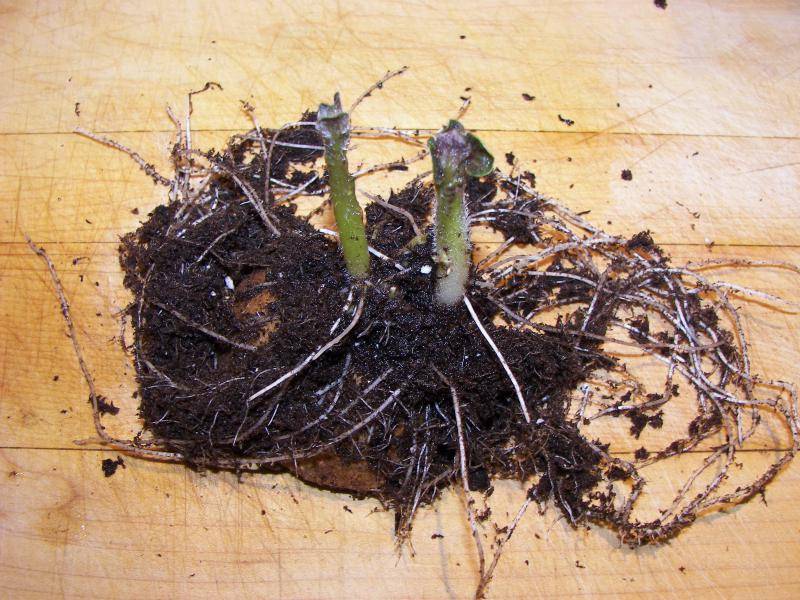
Then I selected two apical scions from a mother plant which I trimmed and cut the stem in a V-shape wedge with a surgical blade:
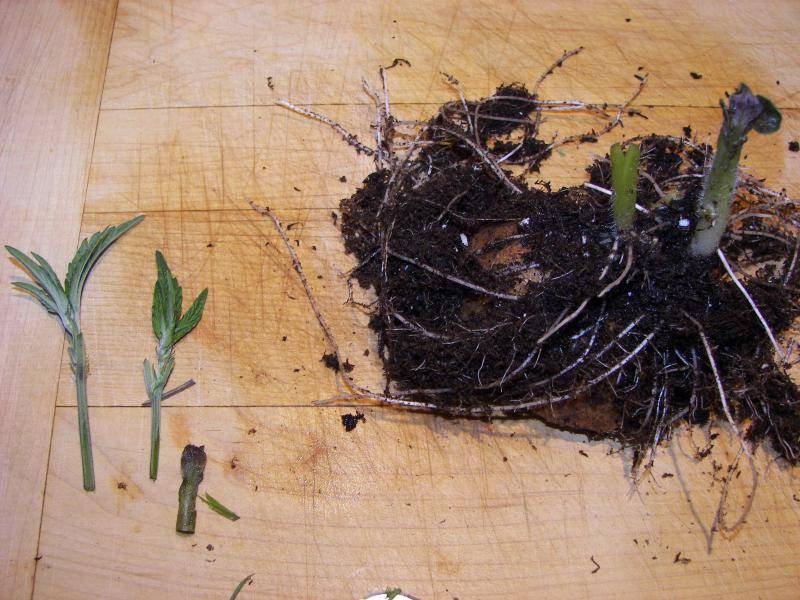
I inserted the scion wedge into the cleft:
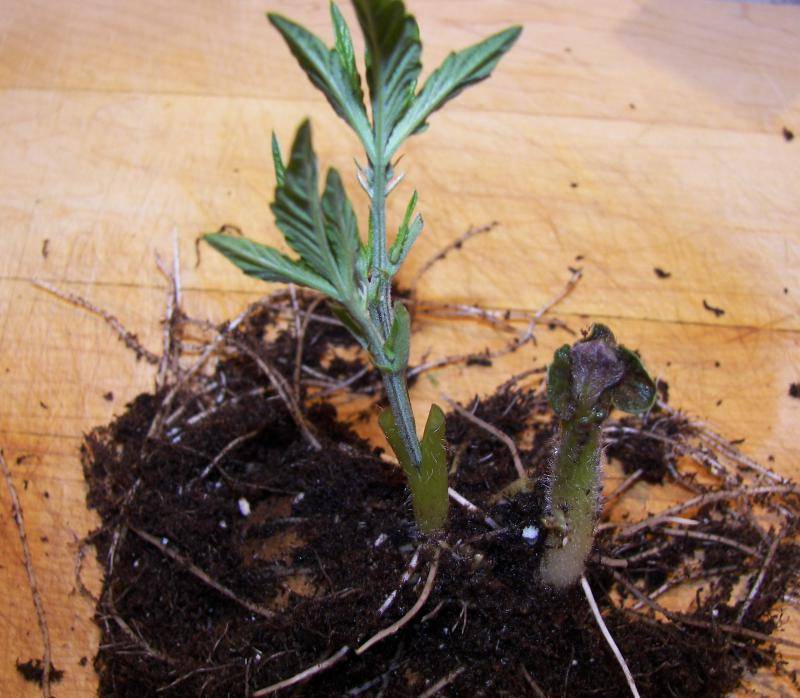

I selected few old potato that were going right in the trash but I decided to cover them with soil for 5 to 6 day...
Here is what I got. I should have wait few more days until the stems develop a little bit more.
Then I selected two apical scions from a mother plant which I trimmed and cut the stem in a V-shape wedge with a surgical blade:
I inserted the scion wedge into the cleft:
Darpa
Member
I did a similar operation on the other stem of the potato and I wrapped everything tightly with plastic wrap.
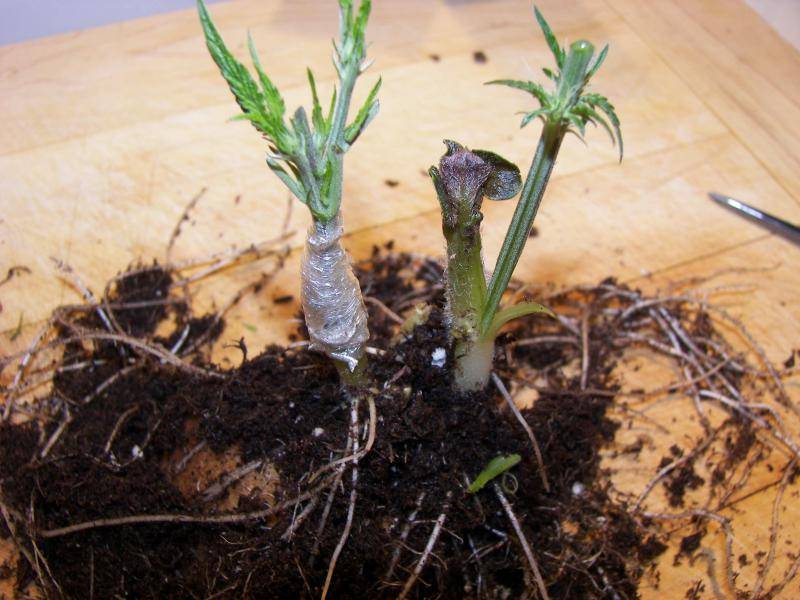
Here is the final result. I will rest in the dome for at least 5 to 7 days. I'll keep you updated!
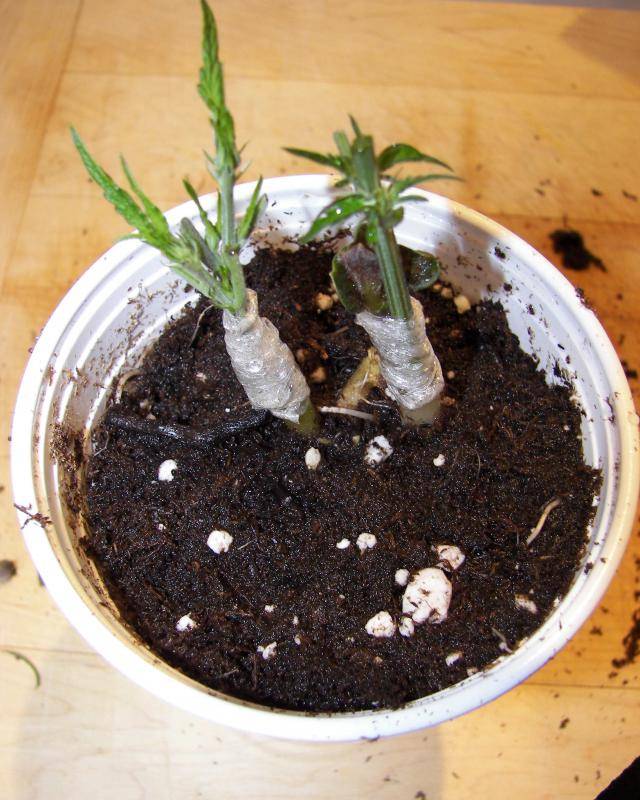
As I said before, we are no where close to a taxonomic proximity which is a general prerequisite for successful graft-take and long-term survival of the grafted. I should give it try on roses plant which would probably work...

Here is the final result. I will rest in the dome for at least 5 to 7 days. I'll keep you updated!
As I said before, we are no where close to a taxonomic proximity which is a general prerequisite for successful graft-take and long-term survival of the grafted. I should give it try on roses plant which would probably work...
It’s been generally recognized that the success of grafting declines as you move up taxonomic rank (although not necessarily absolute). The success of Species to Species > to Gender > to Family > to Order, etc.
Remember the Simpsons episode where Homer creates the tomacco plant. It’s been done in real life and there were traces of nicotine found in the grafted tomato plants leaves. I guess the question is does nicotine naturally occur in tomato plants. Tobacco and tomatoes are in the same family.
Remember the Simpsons episode where Homer creates the tomacco plant. It’s been done in real life and there were traces of nicotine found in the grafted tomato plants leaves. I guess the question is does nicotine naturally occur in tomato plants. Tobacco and tomatoes are in the same family.
Darpa
Member
It’s been generally recognized that the success of grafting declines as you move up taxonomic rank (although not necessarily absolute). The success of Species to Species > to Gender > to Family > to Order, etc.
Remember the Simpsons episode where Homer creates the tomacco plant. It’s been done in real life and there were traces of nicotine found in the grafted tomato plants leaves. I guess the question is does nicotine naturally occur in tomato plants. Tobacco and tomatoes are in the same family.
Tomato fruits and leaves naturally contain a low level of nicotine (2.4–6.0µg kg−1). Tomato fruits and leaves naturally contain a low level of nicotine (2.4–6.0µg kg−1). However when you graft a tomato scion on a tobacco rootstock, the level of nicotine found in the fruit is significantly increased. We have to remember that nicotine is synthesized in the root of the Tobacco plant and then transported to the leaves and the lateral parts of the plant, and its quantity depends on the type of tobacco, nitrogen availability, temperature, light, moisture and injury. Fruits of tobacco-grafted tomato cultivars had been found to contain almost a hundred times higher amounts of nicotine than those of selfrooted plant. Interesting fact, beside the increase of Nicotine, research have demonstrate that Tomato-Tobacco grafting resulted to a 30% increase of total fruit weight compare to ungrafted tomato plant!
Grafting tomato plant on tobacco plant and its effect on tomato plant yield and nicotine content, First published: 17 March 2009
Abstract
BACKGROUND: Two different tomato scions, cv. Elazig and cv. Sweet (cherry) (Solanum lycopersicum L.) were self-grafted and grafted onto tobacco root stock (Nicotiana tobacum L.). Then, grafted tomato plants were evaluated in terms of flower and fruit yield. Tobacco-grafted tomato plant fruits were also evaluated for nicotine content.
RESULTS: Tobacco grafting had a positive effect on the tomato plant cultivation performance; the onset of flowering was almost 15 days earlier and the tomato flower and fruit yields increased in both tomato cultivars. Tobacco grafting resulted in 5.0% and 30.1% increase in total fruit weight for cv. Sweet and cv. Elazig, respectively. Because the level of nicotine was within acceptable ranges, tobacco-grafted tomato fruits were considered to be safe for consumption. Self-grafted tomato cultivars also had flowering time onsets almost 11 days earlier. However, self-grafting caused 6.0% and 7.6% less total fruit yield per cv. Sweet and cv. Elazig, respectively.
CONCLUSION: In conclusion, our results show that tomato–tobacco grafting is a novel and promising technique for improvement of not only tomato plant performance and yield, but also that it can be employed to various tomato varieties.
SuperWeed
Member
Tomato fruits and leaves naturally contain a low level of nicotine (2.4–6.0µg kg−1). Tomato fruits and leaves naturally contain a low level of nicotine (2.4–6.0µg kg−1). However when you graft a tomato scion on a tobacco rootstock, the level of nicotine found in the fruit is significantly increased. We have to remember that nicotine is synthesized in the root of the Tobacco plant and then transported to the leaves and the lateral parts of the plant, and its quantity depends on the type of tobacco, nitrogen availability, temperature, light, moisture and injury. Fruits of tobacco-grafted tomato cultivars had been found to contain almost a hundred times higher amounts of nicotine than those of selfrooted plant. Interesting fact, beside the increase of Nicotine, research have demonstrate that Tomato-Tobacco grafting resulted to a 30% increase of total fruit weight compare to ungrafted tomato plant!
Grafting tomato plant on tobacco plant and its effect on tomato plant yield and nicotine content, First published: 17 March 2009
Abstract
BACKGROUND: Two different tomato scions, cv. Elazig and cv. Sweet (cherry) (Solanum lycopersicum L.) were self-grafted and grafted onto tobacco root stock (Nicotiana tobacum L.). Then, grafted tomato plants were evaluated in terms of flower and fruit yield. Tobacco-grafted tomato plant fruits were also evaluated for nicotine content.
RESULTS: Tobacco grafting had a positive effect on the tomato plant cultivation performance; the onset of flowering was almost 15 days earlier and the tomato flower and fruit yields increased in both tomato cultivars. Tobacco grafting resulted in 5.0% and 30.1% increase in total fruit weight for cv. Sweet and cv. Elazig, respectively. Because the level of nicotine was within acceptable ranges, tobacco-grafted tomato fruits were considered to be safe for consumption. Self-grafted tomato cultivars also had flowering time onsets almost 11 days earlier. However, self-grafting caused 6.0% and 7.6% less total fruit yield per cv. Sweet and cv. Elazig, respectively.
CONCLUSION: In conclusion, our results show that tomato–tobacco grafting is a novel and promising technique for improvement of not only tomato plant performance and yield, but also that it can be employed to various tomato varieties.
I must spread some reputation around before giving it to Darpa again.


